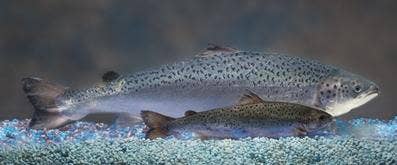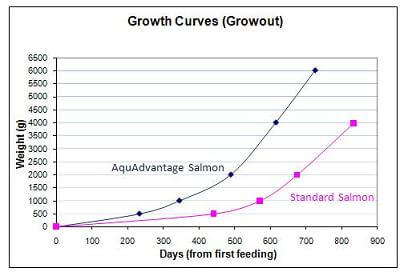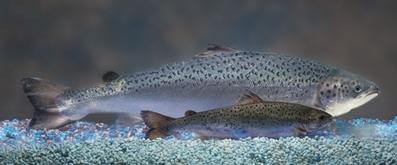Genetically Modified Salmon Could Be On Your Plate Soon

Share
This past Sunday (September 19th) the US FDA held one of the final meetings needed to approve genetically modified salmon for human consumption. If approved, the salmon would be the first transgenic animal available to eat. Aqua Bounty, a biotech firm in Massachusetts, has been seeking FDA sanction for its AquAdvantage Salmon (AAS) since 1995. The AAS is an Atlantic Salmon which has been genetically modified by adding genes from the Ocean Pout and the Chinook Salmon. This allows it to produce growth hormone faster and in all temperatures. AAS develop to adult size in half the time of traditional Atlantic Salmon (18 months rather than 3 years). Though it is quicker growing, the AAS does not become larger than traditional salmon and Aqua Bounty claims that it looks the same, tastes the same, and has the same nutritional value. If they are successful in acquiring FDA approval, the company plans on using the AAS to dramatically scale up salmon fish farming. Take a good look at the AquAdvantage Salmon, the next time you see it could be on your plate.
Aqua Bounty has faced many critiques from environmentalists, food advocates, and even chefs. In 2007, a group of them agreed not to serve the genetically modified fish if it was approved for consumption. According to ABC News, protesters are ready to oppose the recent FDA consideration at well.
Yet the biggest concerns seem to center on the impact errant genetically modified fish could have on wild salmon populations. To that end, Aqua Bounty has been working extensively to demonstrate that it can contain and prevent any genetic spillage. They've introduced a sterilization process and propose to only sell female sterilized fish to farming organizations. Aqua Bounty has also suggested that one of the main benefits of raising AAS will be that it can be farmed away from the ocean, as is often done with trout. Part of their proposal to the FDA, which will be reviewed in the upcoming meeting, details farming methods which will drastically reduce the chances of AAS fish or eggs ever reaching nature.
Aqua Bounty has also been criticized for not making more of its research available for outside scientists to review. Part of the concern probably arises as AquAdvantage Salmon are being reviewed by the FDA under veterinary medicine guidelines, and as such do not require open meetings or the revelation of proprietary research data. Aqua Bounty has, however, recently released many of the documents it presented at the FDA meeting. They can be found here.
If the AAS becomes successful it is likely Aqua Bounty will follow up with transgenic trout and tilapia that it has under development. The AAS could also be followed by other genetically modified animals we've seen in the works such as the 'enviropig' created to produce less environmental waste.

It's hard to argue with a fish that's ready to reach market in half the time. Exponential growth curves never lie.
Why all this interest in genetically modified meat? We need something to replace all the wild animals we've eaten. The current state of our ocean fauna is horrific, and largely a result of human misconduct. It's sad how poorly we've managed these resources. Wild fish populations (salmon among them) have been devastated by fishing practices and there have been major concerns that we're running out of commercial quantities of eatable breeds. Farming fish is a growing market which now perhaps accounts for as much as 47% of the fish we eat. Atlantic salmon, with its high concentrations of fatty acids, rich taste, and thick fillets, is one of the more desirable fish to be farmed. If AAS can eliminate the need to farm in sea pens, it could eliminate a host of concerns including pollution and ecological impact. Again, it's tragic that we've put ourselves into this position, but it looks like GM fish might be a way to dig ourselves out of the hole.
Be Part of the Future
Sign up to receive top stories about groundbreaking technologies and visionary thinkers from SingularityHub.


Of course, genetically modified food has its disadvantages as well. As we've discussed before, GM animals and plants are considered intellectual property, which allows large corporations (*cough* Monsanto *cough*) to establish de facto monopolies on entire categories of crops. Genetic modifications also lead to large populations of a species (animal or plant) to be limited to a single line of genes. These monocultures may have more desirable traits (faster growth times, resistances to parasites, etc) but their lack of diversity could make them more susceptible to being wiped out by a single disease or catastrophe. In the US, consumers are also faced by the problem that few, if any, food stuffs are required to declare they are genetically modified on their labels. There are also many who fear that GM foods will have a negative impact on the people who eat them. This could happen through the loss of vital trace nutrients that traditional and organically raised food possesses, or through the introduction of new substances generated by splicing in new genes into an organism.
For most, the rise of genetically modified food is too new, too untested, and it is the unknown quantity that it represents that is threatening. To be fair to Aqua Bounty, they have been studying their AquAdvantage Salmon for more than a decade, so it's far less untested than some would fear. Also, the genetic modifications they introduced to the AAS cause it to produce more of its own natural growth hormone (the same chemical found in regular Atlantic Salmon). The genes from the Ocean Pout do not give the AAS the 'anti-freeze' of that animal, just some of the genetic signals associated with it, which promote growth hormone production. The rest of critics concerns, from monopolies to monocultures, still stand.
There are alternatives to genetically modified foods, especially for aquaculture. As we've reviewed previously, aquaponics could allow fish farmers to raise large quantities of perch and other lake/river breeds in a manner that is organic and highly productive. Such farms could be reproduced in many cities around the world.
No matter how you look at it though, we are likely to need more fish proteins in the near future. Genetically modified fish that cut growth times in half are simply too appealing to be ignored. Whether or not the FDA finally approves AquAdvantage Salmon for consumption later this month, you can bet that Aqua Bounty and other companies will continue to look to find ways to bring these economically prudent genetically modifications to market. If or when they do, it's likely that many of us will eat them. Hey, at least it's not as creepy as completely synthetic meat.
[image credits: Aqua Bounty]
[sources: Aqua Bounty, FDA, NY Times, Washington Post]
Related Articles

This Week’s Awesome Tech Stories From Around the Web (Through December 20)

Data Centers in Space: Will 2027 Really Be the Year AI Goes to Orbit?

New Gene Drive Stops the Spread of Malaria—Without Killing Any Mosquitoes
What we’re reading
